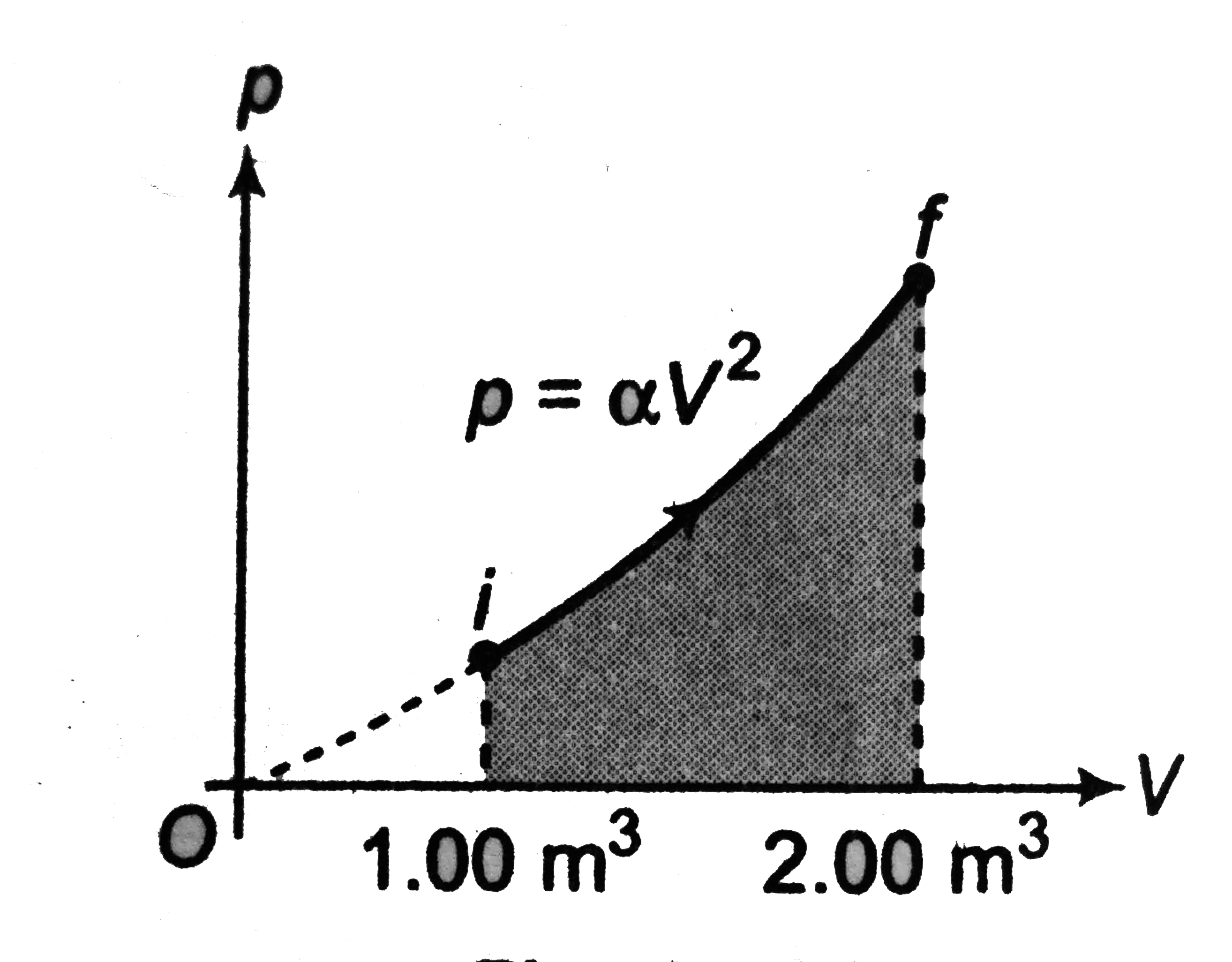A sample of ideal gas is expanded to twice its original volume of 1.00m3 in a quasi-static process for which p=αV2, with α=5.00atm/m6, as shown in Fig. How much work is done by the expanding gas?

The final pressure is 5×4=20atm=2MPa.
The work done on the gas is the negative of the area under the curve P=αV2 From Vi to Vf. The work on the gas is negative, which means that the expanding gas does positive work. We find its value as
W=−∫fiPdV with Vf=2Vi=2(1.00m3)=2.00m3
W=∫vfviαV2dV=−13α(V3f−V3i)
W=−15(5.00atm/m6)(1.013×105Pa/atm)
×[(2.00m3)3−(1.00m3)3]
=1.18×106J
One estimate was good. To do the integal of PdV, we start by indenifying how P depends on V, just as to do the integal of ydx in mathematics you start by identifying how y depends on x.
Topper's Solved these Questions
- KINETIC THEORY OF GASES AND FIRST LAW OF THERMODYNAMICSBOOK - CENGAGE PHYSICSCHAPTER - KINETIC THEORY OF GASES AND FIRST LAW OF THERMODYNAMICSEXERCISE - Solved Examples
14 Videos
- KINETIC THEORY OF GASES AND FIRST LAW OF THERMODYNAMICSBOOK - CENGAGE PHYSICSCHAPTER - KINETIC THEORY OF GASES AND FIRST LAW OF THERMODYNAMICSEXERCISE - Exercise 2.1
20 Videos
- KINETIC THEORY OF GASESBOOK - CENGAGE PHYSICSCHAPTER - KINETIC THEORY OF GASESEXERCISE - Compression
2 Videos
- LINEAR AND ANGULAR SIMPLE HARMONIC MOTIONBOOK - CENGAGE PHYSICSCHAPTER - LINEAR AND ANGULAR SIMPLE HARMONIC MOTIONEXERCISE - Multiple Correct Answer Type
9 Videos
Similar Questions
A sample of ideal gas is expanded to twice of its original volume of 1m^(3) in a quasi-static process for which P=alpha v^(2),alpha=3*10^(5)Pa/m^(6)as shown in fig. Work done by expanding gas is
View SolutionA sample of an ideal gas is expanded to twice its original volume of 1m3 in a reversible process for which P=αV2, where α=5atmm−6. If CV,m=20Jmol−1K−1, determine moalr change in entropy (ΔSm) for the process.
View Solution
Knowledge Check
An ideal gas is taken through a quasi-static process described by P=αV2, with α=5.00atm/m6. The gas is expanded to twice its original volume of 1.00m3. How much work is done by the gas in expanding gas in this process?
A1.8MJB2.18MJC1.28MJD3.18MJ1 g H2 gas expand at STP to occupy double of its original volume. The wok done during the process is
A260 calB180 calC130 calD270 cal16g oxygen gas expands at STP, to occupy double of its original volume. The work done during the process is:
A260 kcalB180 kcalC130 kcalD272.8 kcal
A sample of an ideal gas is expanded 1m3 to 3m3 in a reversible process for which P=KV2 , with K=6bar/m6. What is work done by the gas (in kJ) ?
View SolutionA sample of an ideal gas is expanded from 1dm3 to 3 in a reversible process for which P=KV3, with K=1/5(atm/dm3), what is work done by gas (Latm)
View SolutionTwo litres of an ideal gas at a pressure of 10 atm expands isothermally at 25∘C into a vacuum until its total volume is 10 litres. How much heat is absorbed and how much work is done in the expansion ?
View SolutionThree moles of an ideal gas are expanded isothermally and reversibly at 27∘C to twice its original volume. Calculate q,w, and ΔU.
View Solution5 mole of an ideal gas of volume is expanded against vaccum to make its volume 2 times, then work done by the gas is:
View Solution